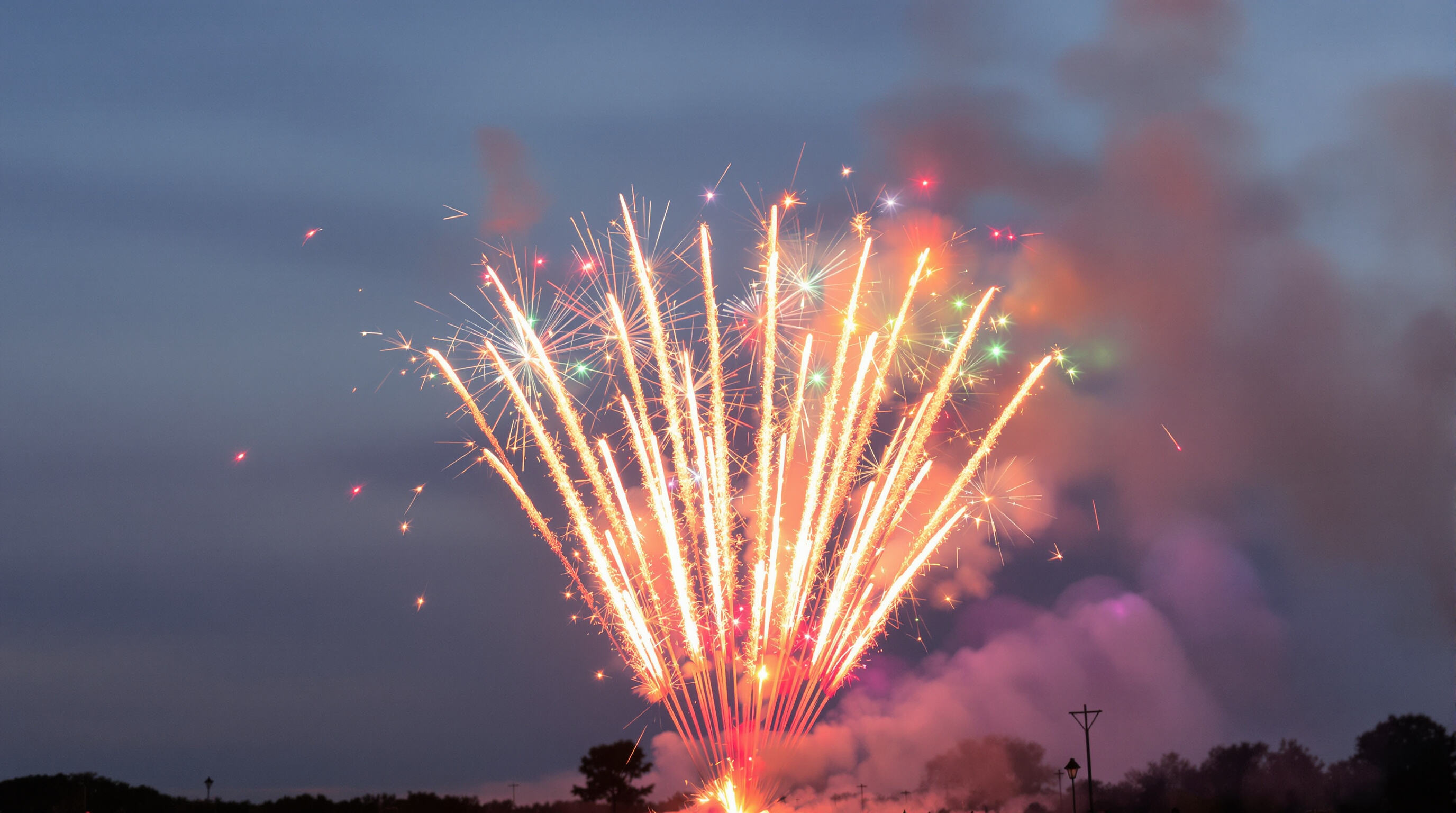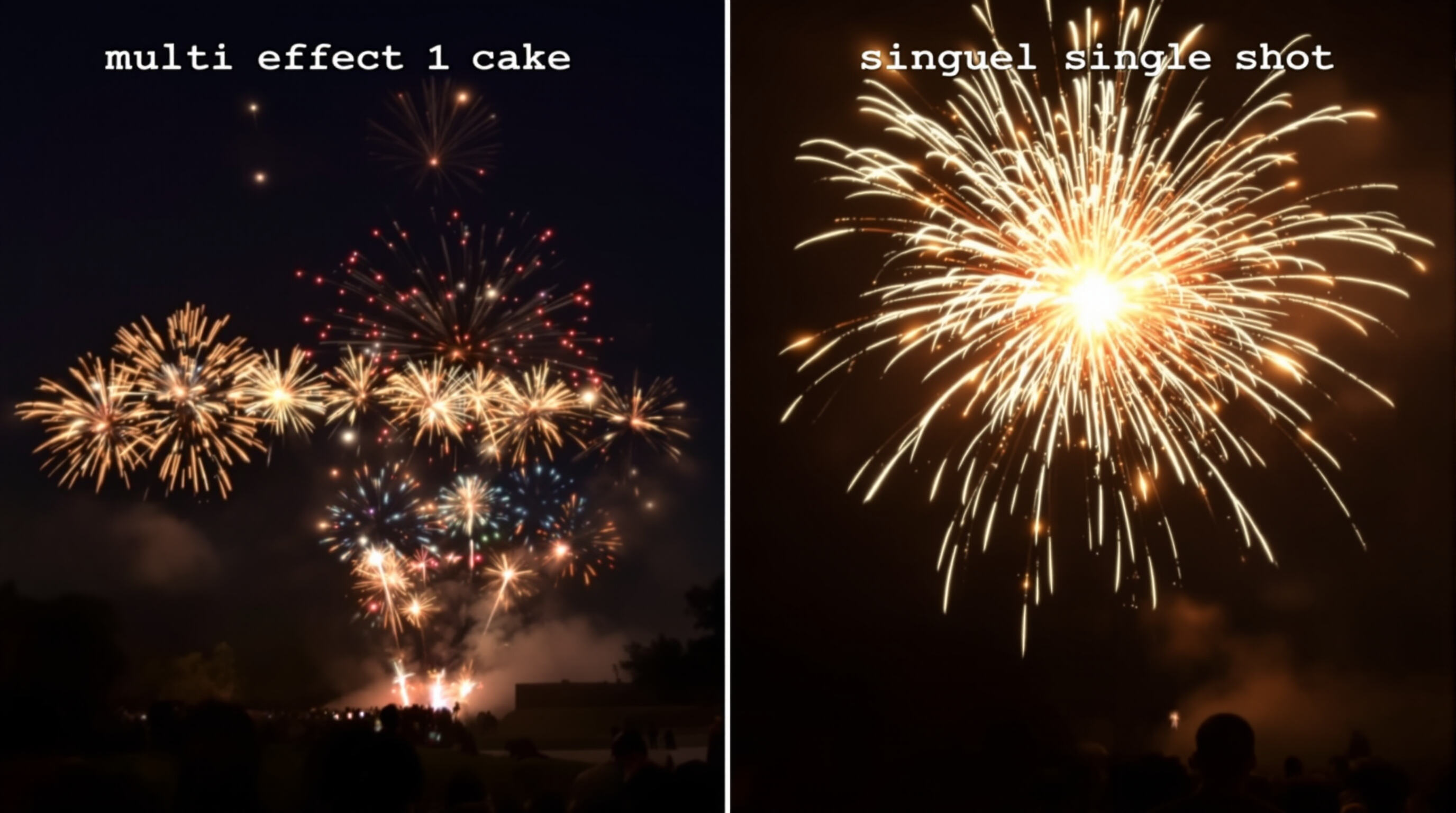What Are Cake Fireworks and How Do They Work?

Definition and Mechanism of Cake Fireworks
What people call cake fireworks, sometimes referred to as barrages or multi shot fireworks, are basically several tubes stuck together into one big package. Once set off, there's this internal timer inside that goes off step by step, sending out all sorts of cool stuff like shooting stars, glowing comets, and those crackling bursts without anyone needing to touch anything else during the show. The whole thing keeps going non stop for about half a minute to maybe ninety seconds after just one initial spark, which makes these kinds of fireworks really good when someone wants something that lasts longer than regular single bang displays but still looks amazing throughout.
Popular Types and Visual Effects of Cake Fireworks
Three primary cake formats dominate the market:
- Straight-firing cakes launch effects vertically for concentrated bursts.
- Fan cakes angle shots horizontally to spread patterns across wider sky areas.
- Compound cakes link multiple units for extended durations (2+ minutes) and layered effects like peonies, willows, or crossettes. These variations produce vibrant color combinations, synchronized sound effects, and dynamic shapes—from chrysanthemum blooms to glittering waterfalls.
Advantages of Cake Fireworks for Large-Scale Impact
Cake fireworks deliver unmatched efficiency for grand events:
- High-impact sequencing: 50–100+ shots fired rapidly maintain audience engagement.
- Simplified logistics: Single ignition reduces setup complexity versus individual shells.
- Sky coverage: Fan and compound types create immersive 360° displays. Their sustained intensity makes cakes ideal for festivals, stadium events, or New Year celebrations where continuous spectacle is prioritized.
Understanding Single Shot Fireworks: Simplicity and Control
How Single Shot Fireworks Differ from Multi-Shell Cakes
Traditional cake fireworks work by launching several shells in sequence after one initial spark, but single shot fireworks are completely different beasts. Each one houses just a single projectile and needs to be fired separately, which gives folks much better control over when and how effects happen. The way these are built actually makes them pretty versatile stuff. Firework enthusiasts love this because they get to pick exactly which effects go where and arrange them however they want instead of being stuck with whatever pattern came pre-programmed into a standard display.
Ideal Use Cases for Single Shot in Private or Small Events
Single shot fireworks excel in intimate settings like backyard celebrations or neighborhood gatherings where controlled pacing enhances the experience. Their flexibility allows hosts to:
- Match effects to specific moments (e.g., coordinating bursts with music playlist)
- Accommodate smaller venues with lower trajectory requirements
- Scale displays economically by purchasing only needed quantities Recent industry surveys show 68% of small-event planners prefer single shots for their budget-friendly customization.
Handling, Safety, and Regulatory Ease of Single Shot Devices
Most places classify these as 1.4g consumer fireworks, which means they come with simpler safety rules than those big commercial grade cakes everyone sees at shows. The fact that they're standalone makes them easier to set up and cuts down on the chances of things going wrong when multiple fireworks are connected together. For regular folks wanting to light something off, many areas don't require special licenses for these types of fireworks, but there's always exceptions depending on where exactly someone lives. Before lighting anything, check what's allowed in your specific location. And remember to keep people at least 15 meters away while using them. Safety first!
Performance Comparison: Duration, Height, and Audience Impact

Visual and Auditory Differences: Cake Fireworks vs. Single Shot
Cake fireworks work by shooting off quick succession of effects from tubes that are loaded ahead of time, one after another. They make these continuous bursts that go up around 200 to 300 feet high, often with matching colors and patterns throughout. On the other hand, single shot fireworks explode all on their own when fired separately. These can reach even higher altitudes, about 300 to 400 feet sometimes, but there's always downtime between each launch since someone has to reload them manually. The sounds are totally different too. Cakes create this rhythmic build up that gets louder and louder until it peaks, whereas individual shots just boom suddenly with plenty of silence in between each explosion. Because they operate so differently, pyrotechnicians have to think about these options when planning what kind of show they want to put on for an audience.
Crowd Engagement and Perceived Spectacle Metrics
Continuous cake displays maintain 78% higher audience attention retention according to event perception studies, as their non-stop sequences prevent visual disengagement. Single shots excel in intimate settings where deliberate pacing allows anticipation buildup between launches. Key engagement metrics show:
- Duration of focus: Cake sequences hold attention 2.3x longer than staggered single shots
- Reaction intensity: Single shots generate 40% stronger immediate crowd reactions per explosion
- Memorability: Cake patterns yield 65% higher brand recall in sponsored events
Industry Trend: Rising Use of Cake Fireworks in Smaller Events
The compact cake system has taken over quite a chunk of backyard parties and wedding events these days, holding around 47% of the market actually. That's triple what it was back in 2020 thanks mainly to easier ignition mechanisms and smaller models that still manage to create those big-time professional fireworks effects. People just want something that looks amazing without all the hassle of complicated setup processes. Looking at sales numbers, compact options beat out regular single shot displays by about three to one when we're talking products priced below $500. The manufacturers aren't sitting still either. They keep coming out with new hybrids that mix automated cake features with some of the customization options people love in traditional single shots. It's an interesting time for the industry right now as they try to balance convenience with personal touches.
Cost, Logistics, and Setup: Budgeting for Your Fireworks Choice
Upfront Costs and Setup Requirements for Cake Fireworks
Cake fireworks typically range from $80-$110 for professional-grade 500-gram units, requiring stable level surfaces and secure mounting to prevent tipping during firing. These multi-shot devices deliver sequenced effects through pre-arranged tubes, eliminating manual reloading but demanding careful placement and angling for optimal visibility.
Affordability and Accessibility of Single Shot Fireworks
Single shot devices cost $10-$15 per shell, offering budget flexibility for smaller displays. Their modular nature allows customized sequencing but requires mortar tubes ($20-$50 each) and potentially electronic ignition systems. This accessibility makes them ideal for backyard events where gradual firing maintains engagement without overwhelming spectators.
Hidden Expenses: Permits, Safety Gear, and Professional Setup
Beyond pyrotechnics, budget for:
- Local permits ($50-$500 depending on jurisdiction)
- Safety equipment: fire extinguishers, gloves, and goggles ($50-$100)
- Professional setup fees ($200-$1000 for complex displays) As noted in industry planning guidelines, these ancillary costs typically add 10-20% to total budgets and are frequently overlooked by first-time organizers.
Choosing the Right Fireworks for Your Event Size and Audience
Large Public Events: Why Cake Fireworks Are the Preferred Choice
When it comes to big events such as festivals or citywide celebrations, cake fireworks are pretty much king of the hill because they offer those amazing synchronized effects that keep going and going. Think about it this way: one standard 120 shot cake can light up the night sky across maybe 300 feet or so for around a minute and a half, with all those explosions happening right on beat with whatever music is playing in the background. The best part? These cakes come already fused together, so no need to reload between shots which makes them absolutely perfect when there's a crowd of over a thousand people watching. According to what we've seen from industry reports, most professionals go with cake fireworks for about four out of five major shows where they really want to make an impression.
Backyard Gatherings: The Rise of Single Shot Fireworks
About two thirds of backyard fireworks displays these days rely on single shot devices because they offer much better control over when things go off and how often. The quieter versions make around 85 decibels compared to traditional firework cakes that blast out 110 decibels, so neighbors aren't as bothered in housing developments. Plus, people can spread out the explosions over time instead of having everything happen at once for maybe 20 or 30 minutes total. Looking at safety numbers, there's another advantage too: single shot setups need only about half the open space required for regular firework cakes, which works well given most suburban yards just aren't that big anyway.
Hybrid Displays: Combining Cake and Single Shot for Maximum Impact
Firework professionals are mixing cake displays with individual shots these days to get just the right mix of wow factor and flexibility. Take this common setup for instance: most pyrotechnicians will fire off about two single rockets every minute leading up to a big finale where they blast away an entire 48-shot cake at once. According to recent surveys from event planners in 2023, shows that combine both methods actually last around a quarter longer than when using only one type of display. And there's another bonus too. When organizers pair different kinds of fireworks strategically, they typically save about 18 cents on the dollar for each minute of show time without losing audience interest. The variety keeps people watching throughout instead of getting bored during long stretches of similar explosions.
FAQ Section
What are cake fireworks?
Cake fireworks, also known as barrages or multi-shot fireworks, are a collection of tubes fused together that produce a continuous display of firework effects for a prolonged period when ignited just once.
What is the main difference between cake fireworks and single shot fireworks?
Cake fireworks release multiple effects in sequence after a single ignition, while single shot fireworks contain one projectile and are manually ignited individually, allowing for better control over timing and display arrangement.
Where are cake fireworks best utilized?
Cake fireworks are ideal for large-scale events like festivals, stadium events, and New Year celebrations due to their continuous and spectacular displays.
When should I use single shot fireworks?
Single shot fireworks are perfect for small or private events such as backyard parties where controlled and customized pacing is desired.
What are the cost implications of using cake versus single shot fireworks?
Cake fireworks generally cost more upfront ($80-$110) but offer comprehensive displays without the need for additional setup, while single shot fireworks are priced per shell ($10-$15) and provide flexibility but may require extra accessories like mortar tubes.
Table of Contents
- What Are Cake Fireworks and How Do They Work?
- Understanding Single Shot Fireworks: Simplicity and Control
- Performance Comparison: Duration, Height, and Audience Impact
- Cost, Logistics, and Setup: Budgeting for Your Fireworks Choice
- Choosing the Right Fireworks for Your Event Size and Audience
- FAQ Section


